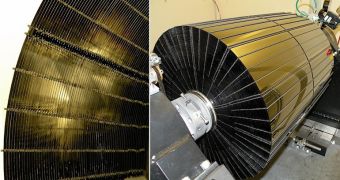NASA officials have recently announced that the American space agency's latest mission to study high-energy phenomena in the Universe will launch no earlier than June 13. The Nuclear Spectroscopic Telescope Array (NuSTAR) will study neutron stars, black holes, the first galaxies and the Sun.
These are just some of its targets. The machine is a fundamentally new, high-energy X-ray telescope that can be focused on different targets. This represents the first time such a capability was implemented on an orbital observatory.
NuSTAR will take off from a launch pad on Kwajalein Atoll in the central Pacific Ocean, in the forward section of an Orbital Sciences Corporation (OSC) Pegasus XL rocket. This will be attached to the L-1011 Stargazer aircraft, which will release it high in the atmosphere.
A clear launch date has not yet been set. NuSTAR is scheduled to be installed underneath the Stargazer tomorrow, June 2. The aircraft will take off from the Vandenberg Air Force Base (VAFB), in California, on June 5 or June 6.
“We will see the hottest, densest and most energetic objects with a fundamentally new, high-energy X-ray telescope that can obtain much deeper and crisper images than before,” Fiona Harrison explains.
She is the one who first conceived the X-ray telescope, about two decades ago. The researcher is currently the mission's principal investigator, and is based at the California Institute of Technology (Caltech), in Pasadena.
“NuSTAR uses several innovations for its unprecedented imaging capability and was made possible by many partners. We're all really excited to see the fruition of our work begin its mission in space,” adds NuSTAR mission manager Yunjin Kim, from the NASA Jet Propulsion Laboratory (JPL), in Pasadena.
According to its technical sheet, the observatory will be 100 times more sensitive, and will have 10 times the resolution of any previous X-ray telescope deployed to Earth's orbit, even though it operates in the same energy range.
NuSTAR will augment the observations of the NASA Chandra X-ray Observatory, which surveys about the same targets, but in lower-energy X-ray wavelengths.
“NuSTAR truly demonstrates the value that NASA's research and development programs provide in advancing the nation's science agenda,” NASA Astrophysics Division Director, Paul Hertz, says.
“Taking just over four years from receiving the project go-ahead to launch, this low-cost Explorer mission will use new mirror and detector technology that was developed in NASA's basic research program and tested in NASA's scientific ballooning program,” he concludes.

 14 DAY TRIAL //
14 DAY TRIAL //